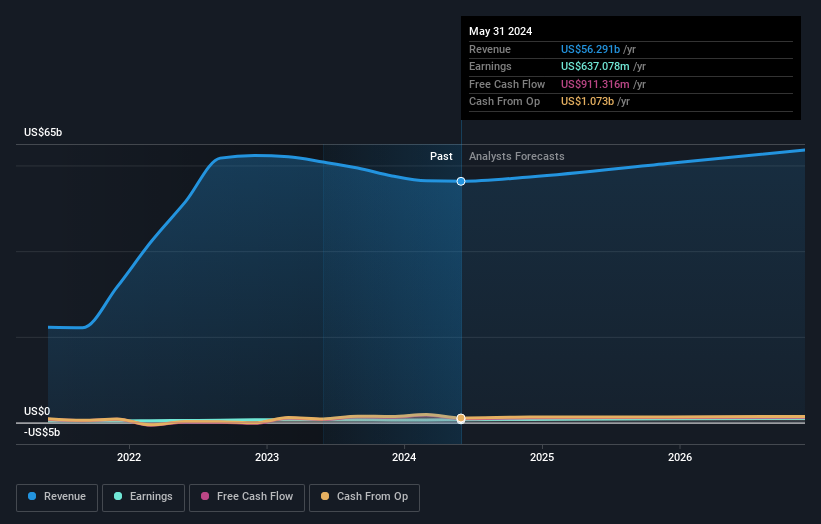What Does TD SYNNEX Corporation's (NYSE:SNX) Share Price Indicate?
Today we're going to take a look at the well-established TD SYNNEX Corporation (NYSE:SNX). The company's stock saw significant share price movement during recent months on the NYSE, rising to highs of US$133 and falling to the lows of US$110. Some share price movements can give investors a better opportunity to enter into the stock, and potentially buy at a lower price. A question to answer is whether TD SYNNEX's current trading price of US$113 reflective of the actual value of the large-cap? Or is it currently undervalued, providing us with the opportunity to buy? Let’s take a look at TD SYNNEX’s outlook and value based on the most recent financial data to see if there are any catalysts for a price change.
Check out our latest analysis for TD SYNNEX
Is TD SYNNEX Still Cheap?
Great news for investors – TD SYNNEX is still trading at a fairly cheap price according to our price multiple model, where we compare the company's price-to-earnings ratio to the industry average. In this instance, we’ve used the price-to-earnings (PE) ratio given that there is not enough information to reliably forecast the stock’s cash flows. we find that TD SYNNEX’s ratio of 15.22x is below its peer average of 22.19x, which indicates the stock is trading at a lower price compared to the Electronic industry. Although, there may be another chance to buy again in the future. This is because TD SYNNEX’s beta (a measure of share price volatility) is high, meaning its price movements will be exaggerated relative to the rest of the market. If the market is bearish, the company’s shares will likely fall by more than the rest of the market, providing a prime buying opportunity.
Can we expect growth from TD SYNNEX?

Future outlook is an important aspect when you’re looking at buying a stock, especially if you are an investor looking for growth in your portfolio. Although value investors would argue that it’s the intrinsic value relative to the price that matter the most, a more compelling investment thesis would be high growth potential at a cheap price. With profit expected to grow by 45% over the next couple of years, the future seems bright for TD SYNNEX. It looks like higher cash flow is on the cards for the stock, which should feed into a higher share valuation.
What This Means For You
Are you a shareholder? Since SNX is currently trading below the industry PE ratio, it may be a great time to increase your holdings in the stock. With an optimistic profit outlook on the horizon, it seems like this growth has not yet been fully factored into the share price. However, there are also other factors such as capital structure to consider, which could explain the current price multiple.
Are you a potential investor? If you’ve been keeping an eye on SNX for a while, now might be the time to enter the stock. Its buoyant future profit outlook isn’t fully reflected in the current share price yet, which means it’s not too late to buy SNX. But before you make any investment decisions, consider other factors such as the track record of its management team, in order to make a well-informed assessment.
In light of this, if you'd like to do more analysis on the company, it's vital to be informed of the risks involved. For example - TD SYNNEX has 1 warning sign we think you should be aware of.
If you are no longer interested in TD SYNNEX, you can use our free platform to see our list of over 50 other stocks with a high growth potential.
Mobile Infrastructure for Defense and Disaster
The next wave in robotics isn't humanoid. Its fully autonomous towers delivering 5G, ISR, and radar in under 30 minutes, anywhere.
Get the investor briefing before the next round of contracts
Sponsored On Behalf of CiTechValuation is complex, but we're here to simplify it.
Discover if TD SYNNEX might be undervalued or overvalued with our detailed analysis, featuring fair value estimates, potential risks, dividends, insider trades, and its financial condition.
Access Free AnalysisHave feedback on this article? Concerned about the content? Get in touch with us directly. Alternatively, email editorial-team (at) simplywallst.com.
This article by Simply Wall St is general in nature. We provide commentary based on historical data and analyst forecasts only using an unbiased methodology and our articles are not intended to be financial advice. It does not constitute a recommendation to buy or sell any stock, and does not take account of your objectives, or your financial situation. We aim to bring you long-term focused analysis driven by fundamental data. Note that our analysis may not factor in the latest price-sensitive company announcements or qualitative material. Simply Wall St has no position in any stocks mentioned.
Have feedback on this article? Concerned about the content? Get in touch with us directly. Alternatively, email editorial-team@simplywallst.com
About NYSE:SNX
TD SYNNEX
Operates as a distributor and solutions aggregator for the information technology (IT) ecosystem.
Undervalued with excellent balance sheet.
Similar Companies
Market Insights
Weekly Picks

Early mover in a fast growing industry. Likely to experience share price volatility as they scale


A case for CA$31.80 (undiluted), aka 8,616% upside from CA$0.37 (an 86 bagger!).


Moderation and Stabilisation: HOLD: Fair Price based on a 4-year Cycle is $12.08
Recently Updated Narratives


Title: Market Sentiment Is Dead Wrong — Here's Why PSEC Deserves a Second Look


An amazing opportunity to potentially get a 100 bagger

Amazon: Why the World’s Biggest Platform Still Runs on Invisible Economics
Popular Narratives


Crazy Undervalued 42 Baggers Silver Play (Active & Running Mine)


MicroVision will explode future revenue by 380.37% with a vision towards success


NVDA: Expanding AI Demand Will Drive Major Data Center Investments Through 2026
Trending Discussion


